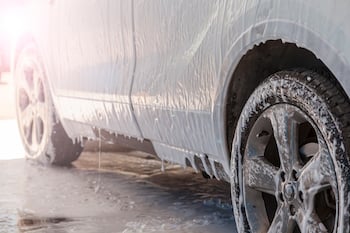 At Safe-T-Cover, we constantly preach about protecting our most precious natural resource: water.
At Safe-T-Cover, we constantly preach about protecting our most precious natural resource: water.
A sound municipal Cross-Connection Control program combined with design best practices of above-ground installation will ensure that your water supply is soundly protected. But when your system is not properly protected, backflow events will occur, and your water supply will be put in danger.
Here’s a quick case history of a backflow incident that occurred at a location common to us all — a car wash.
CASE HISTORY
One morning, many residents in the Greenwood District of Seattle, WA, began complaining about "grey-green and slippery," "muddy," or "soapy" water coming from the taps in their homes. One resident brought a water sample to the Seattle Water Quality Laboratory and preliminary analysis revealed the water was contaminated with a detergent solution. The Seattle Water Department dispatched an emergency field crew to initiate the flushing of hydrants in the affected area. Investigation revealed that recycled wash/rinse water at a large car wash facility had backflowed into the public water system.
The first domino in this chain of events was a high-pressure pump at the car wash facility that broke down. This pump was used to pump recycled rinse water to the scrubber cycle of the car wash, which was not normally connected to the potable water system at the car wash. After the pump broke down, workers kept the car wash operating by connecting a 2” hose between the car wash's potable water system and the piping in the scrubber cycle.
Later that week, the owner of the car wash repaired the high-pressure pump and turned it on. Unfortunately, nobody removed the hose connection between the potable water supply and the scrubber-cycle piping. Unbeknownst to car wash personnel, the high-pressure pump forced a large quantity of recycled rinse water through the hose connection, the rinse-cycle piping and the car wash's potable water system into the public water system. This recycled rinse water was, in turn, distributed to the potable water systems of homes and commercial establishments in the surrounding area. Sometime later, a car wash employee flushed the toilet in the car wash's restroom and noticed brown soapy water in the toilet bowl. Car wash personnel quickly realized they had created a cross-connection and removed the hose between the rinse-cycle piping and the scrubber-cycle piping.
After finding the source of the soapy water problem, the city water department conducted water main flushing to intercept and limit the scope of the contamination. Because of its prompt response, the city water department confined the contamination to an eight-block area.
Nevertheless, the city water department delivered a public notification statement to six radio and television stations. Two people in the contaminated area reported illness after drinking the water. The city water department ordered the owner of the car wash facility to install an RPZ backflow preventer in the potable water connection to the car wash. The owner complied within 24 hours.
Sometimes business owners make quick fixes to their plumbing system which inadvertently creates cross-connections and puts our drinking water supply in danger. These events happen every day in all parts of the country, and the only thing protecting our water supply from contamination is a solid Cross-Connection Control program and properly working backflow preventers.




